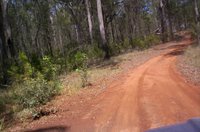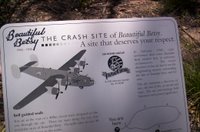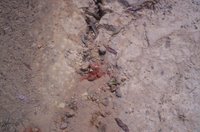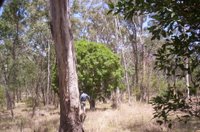HOYAS I HAVE GROWNJan Sked
Pine Rivers
All my Hoyas are grown in hanging baskets that are located in trees or shrubs in the garden. Some of the baskets eventually fall to bits and the Hoyas drop down into the garden and either continue to thrive or disappear forever. I use small hanging baskets, 200mm in diameter, as Hoyas prefer to have their roots constricted. The mix I use in the baskets is two parts premium commercial potting mix, one part sand and one part coir peat. It is the same mix I use in most of my pots.
The first Hoya I ever grew was given to me by well known Queensland SGAP member Merv Hodge in 1977. It was simply known as
Hoya australis. I do not know which subspecies it belongs to. It is still growing on a fence in the garden, but has not been a very good flowerer. The leaves are particularly large, up to 16cm long and quite glabrous. The flowers are white, fairly small and in sparse clusters.
My next two
Hoya australis were given to me by Norm McCarthy of Toowoomba in 1979. Once again I do not know which subspecies. These two seem to have died out, as I have not seen them for some years.
In 1982 I obtained a plant at the SGAP Flower Show which was labelled
Hoya keysii. In later years this became
Hoya australis ssp. australis, and it has proven to be by far my best Hoya. I have grown many plants from cuttings from this plant and distributed it amongst many SGAP members and friends. It has pale green felty leaves and the showy flower heads are up to 7cm across with about 20 pure white waxy fragrant flowers. I believe the first collection of this species was made at Mt. Perry in 1884.
In 1982 I also obtained a specimen of
Hoya australis ssp tenuipes from the SGAP Flower Show, probably from David Liddle. It was labelled at the time as "Hoya sp. Langkelly Creek". The leaves are thick, light green, with undulate margins. It flowers in October with heads of white fragrant flowers, about 1 - 1.5cm across, not as numerous or quite as large as
Hoya australis ssp. australis.In 1985 I added another of David Liddle's Hoyas to my collection. This time it was
Hoya australis ssp. oramicola, labelled at that time as
Hoya sp. aff. australis. This species comes from the Northern Territory and the north-west of Western Australia. The dark green leaves are thick and glabrous, and when juvenile the edges are tightly recurved. The heads of white flowers are smaller than the other
Hoya australis I have grown. It flowers in March.
Hoya potsii is a very successful Hoya in the garden. It was known for many years as
Hoya nicholsoniae, and occurs naturally in north Queensland, from the Iron Range to Townsville. The foliage is an attractive feature of this plant. Leaves are oval-shaped, thick and fleshy, with pronounced parallel silvery venation. They assume shades of maroon, copper, red and purple in bright light. The flowers are cream to pale yellow, 1 - 1.5cm across, in dense heads of up to 30 flowers. Their perfume can usually be detected towards evening. Flowering in my plant has been recorded from October to January. I obtained this plant in 1981 from Fairhill Nursery at Yandina.
The rare and spectacular
Hoya macgillivrayi is very hard to get to flower in my garden. In fact, it is pretty touchy to keep alive at all. It occurs naturally in the McIlwraith and Iron Ranges of Cape York Peninsula. My first one was a gift from a Pine Rivers member in 1981. I lost it after a number of years, probably because the position I had it in was not very good. It did flower for me a couple of times and these flowers are well worth waiting for. The flowers were in umbels of seven, each flower about 6cm across, a purple colour shading to white at the centre of the corolla. I grew a second specimen from cutting from this plant, but both have since passed out of existence.
My third and fourth
Hoya macgillivrayi were obtained from the SGAP Flower Show in 2001. They are both growing quite well - one in full shade within my rainforest and the other on the edge of the rainforest where it gets good light, but little direct sunlight. Interestingly, the one that has flowered has been the one in deep shade. The flower colour is different from the first two specimens I had. This one has reddish-purple flowers with no white in the centre.
At the SGAP Flower Show in 1981 I obtained a plant labelled
Hoya rubida. It has also gone under the name of
Hoya lauterbachii, and is now reclassified as
Hoya sussuela, This one is very striking with flower heads of up to 12 dark red waxy flowers (5cm across). The outer part of the corolla is a light fawn-brown colour, making it an interesting contrast. It flowers from March to May. This one comes from north Queensland in the McIlwraith Range area. Sadly, I eventually lost this one and have never been able to find a replacement.
Another species that I have grown but since lost is
Hoya anulata. This is listed as a rare plant. Two of these species came my way via David Liddle in 1982 and 1983. This species has gone under the names
Hoya pseudolittoralis and
Hoya poolei. This one comes from the Iron Range area of north Queensland. The leaves are about 5cm long, oval-shaped and fleshy. They turn bronze to red when exposed to the sun. The flowers are in loose umbels of about 10 flowers, and these are pale pink to white with dark pink centres.
Two unamed hoya species were also obtained in 1983. One was labelled
Hoya sp. Bamaga and the other
Hoya sp. aff. holrunghii.. These two have disappeared into the garden and have not been seen for some time. I don't remember what the flowes were like, but I believe they were white in both cases.
Another
Hoya species from north Queensland was given to me by a former SGAP member in 2003. It has not yet flowered for me, but the person I got it from gave me a photo of the flowers, which appear to be about 2-3cm across and pure white, in umbels of seven. The plant has very large leaves, up to 18cm lon. Both stems and undersides of the leaves are hairy.
I also have a few exotic Hoyas that came my way. The first is
Hoya carnosa (Pink Wax Flower), which has been a favorite in general cultivation for many years. It was originally believed to be a native species, but these days it is not recognised as such. I believe it grows on Christmas Island, which is an Australian Territory. This species has flowered regularly for me from October through to March ever since I got it, and the flowers are quite beautiful - pale waxy pink with deeper pink centre, in tight umbels of 20 or more. A very attractive species, it has given rise to various cultivars, of which I have two.
One of the cultivars is
Hoya carnos variegated, which has fleshy cream, green and pink leaves. It is supposed to have fragrant pink flowers, but so far has not flowered for me. In fact, it does not appear to be a particularly happy plant.
The other cultivar is quite spectacular. I call it
Hoya 'Black Magic'. The leaves when young are almost black with pink and cream splashes on purple-black stems. These gradually change to green with white splashes on green stems. Leaves and stems are glabrous. It is a very vigorous grower and flowers profusely from October through January. The flowers need to be seen to be believed. They are 1.5cm across, velvety black with red centres in tight umbels of up to 30. I have given away many cutting grown plants of this one, as anyone who sees it in flower wants it.
Another exotic I actually bought from Big W is
Hoya purpurea-fusca. It has glabrous leaves up to 13cm long with 3-5 parallel veins from the base. According to the label the flowers are lightly fragrant, 1cm across, in large clusters. They are light pink with darker pink centres. So far I have been a bit disappointed with the flowers. Very few have been produced and they have only been in fairly sparse umbels, but they are quite pretty, although not as attractive as the label shows. It is growing quite well.
My last and very exciting Hoya is another one from my ex-SGAP friend, who thought it was probably an exotic. I got it from him in 2003 and it has produced its first flowers in February this year. What a surprise they proved to be - large flowers 6cm across in umbels of 7, with creamy-yellow corolla with maroon edges. The leaves are thick and leathery, up to 18 cm long by 5-8cm wide, mostly with undulate margins. New leaves and stems are hairy, but old stems and leaves seem to lose much of this hairiness. I was so excited when it flowered that I took some photos and emailed them off to Paul Forster at the Queensland Herbarium, who was able to identify it immediately for me. It is
Hoya imperialis from Malaysia.
I hope to add more species to my collection, although I am running out of trees to attach them in. I would like to obtain again some of the ones that I have lost over the years.













